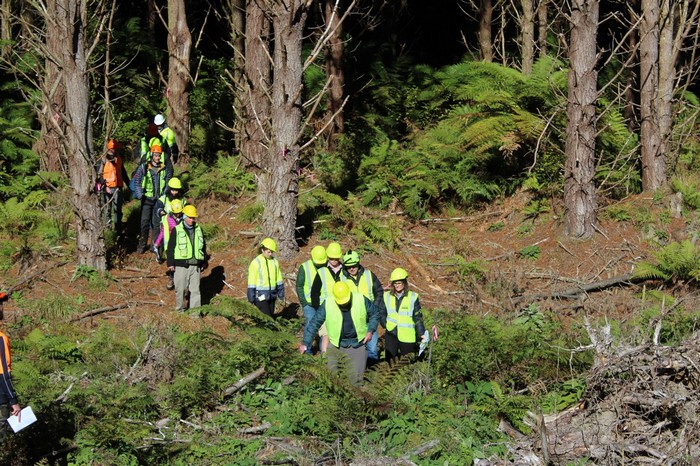Research aims to future-proof planted forests
12 July 2023
Research and smart technologies are offering hope and solutions to growers needing to create more resilient planted forests and mitigate the effects of climate change on tree health and industry productivity.
Although the forestry and wood processing sector is the best positioned of all industries to help New Zealand meet its net-zero emission targets by 2050, the impact of climate change on pine forests through disease, market challenges and the loss of social license poses an economic risk for managers wanting to grow better quality wood for export and meet the local demand for high-value biobased products and fuels made from fibre.
Scion’s Resilient Forests Research Programme was developed in 2019 with support from industry to mitigate any market uncertainty and future proof planted Pinus radiata forests from the effects of climate change.
Geared towards de-risking forestry investments and helping owners make better management decisions, Scion’s research has focused on three key areas: managing risk and uncertainty, enhanced productivity and quality, and enhanced resilience to the impact of pine needle diseases, such red needle cast. The programme has been funded to the tune of more than $18 million over five years from Scion’s Strategic Science Investment Fund and the Forest Growers Levy Trust.
At a two-day conference in June hosted by Scion in Rotorua, 60 people from across the forestry sector and government heard how research has been tracking.

Principal scientist and programme lead Peter Clinton says that scientists enjoyed the opportunity to present their research and connect with people in the industry to hear first-hand what issues matter most.
“Understandably, the industry is concerned about its future under climate change and general market volatility. Trees that will be harvested by 2050 are already in the ground so they want to know what does the future hold for those trees.
“Are we going to see more or less disease among those trees and what are the other big drivers for change across the industry that they need to factor in? Should they diversify their planting to manage any risk? These are the questions that our research is seeking to answer, as well as provide the industry with tools and recommendations to support more informed decision-making for planting and tree health management.
“What’s clear is that taking a business-as-usual approach to managing New Zealand’s planted forests is no guarantee of success in an uncertain world.”
A range of research topics was shared with conference participants, including a review of New Zealand’s forest companies’ sustainable activities. The research, led by Dr Grace Villamor, is exploring how companies report on sustainability – efforts that are a measure of their corporate social responsibility. Her work under the Resilient Forests Programme is also surveying forest managers to better understand how they are adapting their practices to the likely future impacts of climate change.

Scion’s research relating to the monitoring, modelling and control of red needle cast was also covered, with scientists updating conference participants on their work to better understand the red needle cast disease cycle. This is leading onto further data collection work and modelling that aims to more accurately predict when an outbreak of red needle cast might begin, peak and end based on weather forecasts.
Red needle cast is a disease affecting radiata pine and other conifer species and is caused by infection from Phytophthora pluvialis. It is predominately found on the East Coast and Central North Island but more reports are being received from other parts of the country.
When trees are infected, needles discolour then drop from the tree. Research presented by David Lane revealed how defoliation can impact tree growth rates for three years after the trees first shows symptoms of the disease.
With prevention measures needed to support industry to better manage red needle cast and other pine needle diseases, Stuart Fraser, research group leader for Ecology and Environment at Scion, updated conference attendees on the progress of research trials that have examined the timing for applying fungicidal sprays, and their effectiveness. These include copper control options for red needle cast and more environmentally friendly metal salt options for control of Dothistroma needle blight.
Day two of the conference featured a visit to research sites at Kinleith Forest. Led by Scion's team, including Blaise Ratcliffe, Damien Sellier, David Pont, Natalie Graham, and Peter Massam, attendees had the opportunity to observe the ongoing red needle cast control trials that have been underway since 2019. The group gained valuable insights into Scion's methods for controlling and predicting red needle cast, and witnessed the application of cutting-edge technology, such as UAVs and satellite imagery, that researchers are using to collect data for more accurate and repeatable mapping of unhealthy pine forests.
Forest Growers’ Research chief executive Paul Adams says the Resilient Forests Programme is a key investment in the industry’s research and development portfolio.
“It’s about developing core research that enhances and protects the future of the P. radiata estate in New Zealand - resilience.” The programme covers productivity and stand management, wood quality, management of pests and diseases; and risk and uncertainty, and builds on two successful programmes: Healthy Trees, Healthy Future and Growing Confidence in Forestry’s Future.

